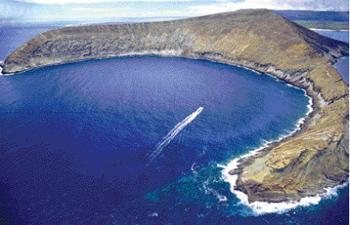LIHU‘E — Habitat-restoration biologists in August discovered more rats on Lehua, an uninhabited island near Ni‘ihau, and plans are to eradicate the feral animals within two to three weeks, a federal spokesperson said Tuesday. As with other eradication efforts, a
LIHU‘E — Habitat-restoration biologists in August discovered more rats on Lehua, an uninhabited island near Ni‘ihau, and plans are to eradicate the feral animals within two to three weeks, a federal spokesperson said Tuesday.
As with other eradication efforts, a multi-agency team of state, federal and military officials will use bait stations and hand-applied rodenticide in an attempt to eliminate the remaining rats, said Ken Foote, information and education specialist with the U.S. Fish and Wildlife Service.
In September, a team including employees of the state Department of Land and Natural Resources Division of Forestry and Wildlife, U.S. Army, U.S. Department of Agriculture and U.S. Fish and Wildlife Service caught 128 rats, after the habitat-restoration people caught one rat in August and saw rats had damaged water irrigation systems, Foote said.
What hasn’t been determined to date is whether the rats are a “residual population” or reintroduced population after the January helicopter release of rodenticide, he said.
A residual population would result if some rats on the island either did not eat the bait or didn’t eat enough of it to die, he said. There is also the possibility that passing ships or boats may have inadvertently released rats onto the island, or someone deliberately reintroduced the rats, he said.
Regardless, the time is now to eliminate or control the introduced species of Polynesian rat on Lehua, Foote said. The population is low and believed to be confined to one small section of the 300-acre island around 50 miles north of Ni‘ihau.
Finding funding is a problem with this rat-eradication plan, he said, with money most likely to come from another source within the U.S. Fish and Wildlife Service. Federal officials are working on cost estimates for the work.
Foote said multi-agency cooperation is also involved in formulating a plan of “biosecurity controls” to prevent inadvertent introduction of non-native plants, animals, insects and other living organisms to Lehua.
Federal officials are reaching out to large landowners and cultural practitioners, as well as residents of Ni‘ihau, in efforts “to dispel rumors and create a positive work environment,” Foote said.
A stakeholder meeting was held Tuesday in Kekaha, mostly to let community members and large landowners know the rodenticide release was not the cause of the Ni‘ihau fish kill earlier this year, Foote said.
Federal and state officials are both sure that a fish kill reported on Ni‘ihau earlier this year was not due to the rodenticide dropped on Lehua in January, said Foote.
Whales, monk seals and various fish were tested, and none were determined to have been killed by the rodenticide, he said.
The second planned rat-elimination effort is once again not sitting well with the people of Ni‘ihau, said Keith Robinson, whose family owns the island, and Ilei Beniamina, whose family is from the Forbidden Island.
From January to July, Ni‘ihau residents couldn’t catch fish on the north end of the island, and they believe this was due to the January air drop of rodenticide at Lehua, Beniamina said.
With no Safeway or Costco on Ni‘ihau, “that’s their icebox,” she said of the ocean.
“We had a nice fishery over there,” with monk seals and enough fish caught locally to feed those on Ni‘ihau, Robinson said.
But since the U.S. Fish and Wildlife Service and National Tropical Botanical Garden people showed up on Lehua, there have been problems with the local fishery, he said.
“What happens on Lehua affects Ni‘ihau,” and the people of Ni‘ihau are politely saying “no” to those wishing to conduct rat-eradication efforts on Lehua, Beniamina said.
Robinson said he is worried about what the rodenticide will do to other organisms if it spreads off Lehua. “We just don’t know.”
He said it makes him mad that officials won’t do what he suggests, to round up some tropical fish, put them in an aquarium, drop the rodenticide pellets inside the tank and see what happens.
NTBG is responsible in part for the re-vegetation effort on Lehua. Chipper Wichman said Monday that NTBG is not involved in any way with the rat eradication effort.
“Our sole role in that project is to help grow and disburse native plants; nothing to do with the rat eradication,” he said. “We’re growing plants and collecting seeds and doing the planting. That’s our specialty.”
• Paul C. Curtis, staff writer, can be reached at 245-3681 (ext. 224) or pcurtis@kauaipubco.com.


